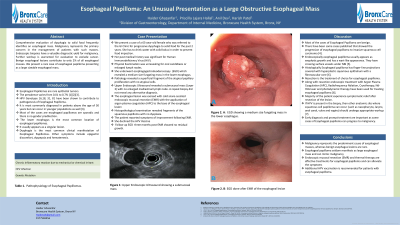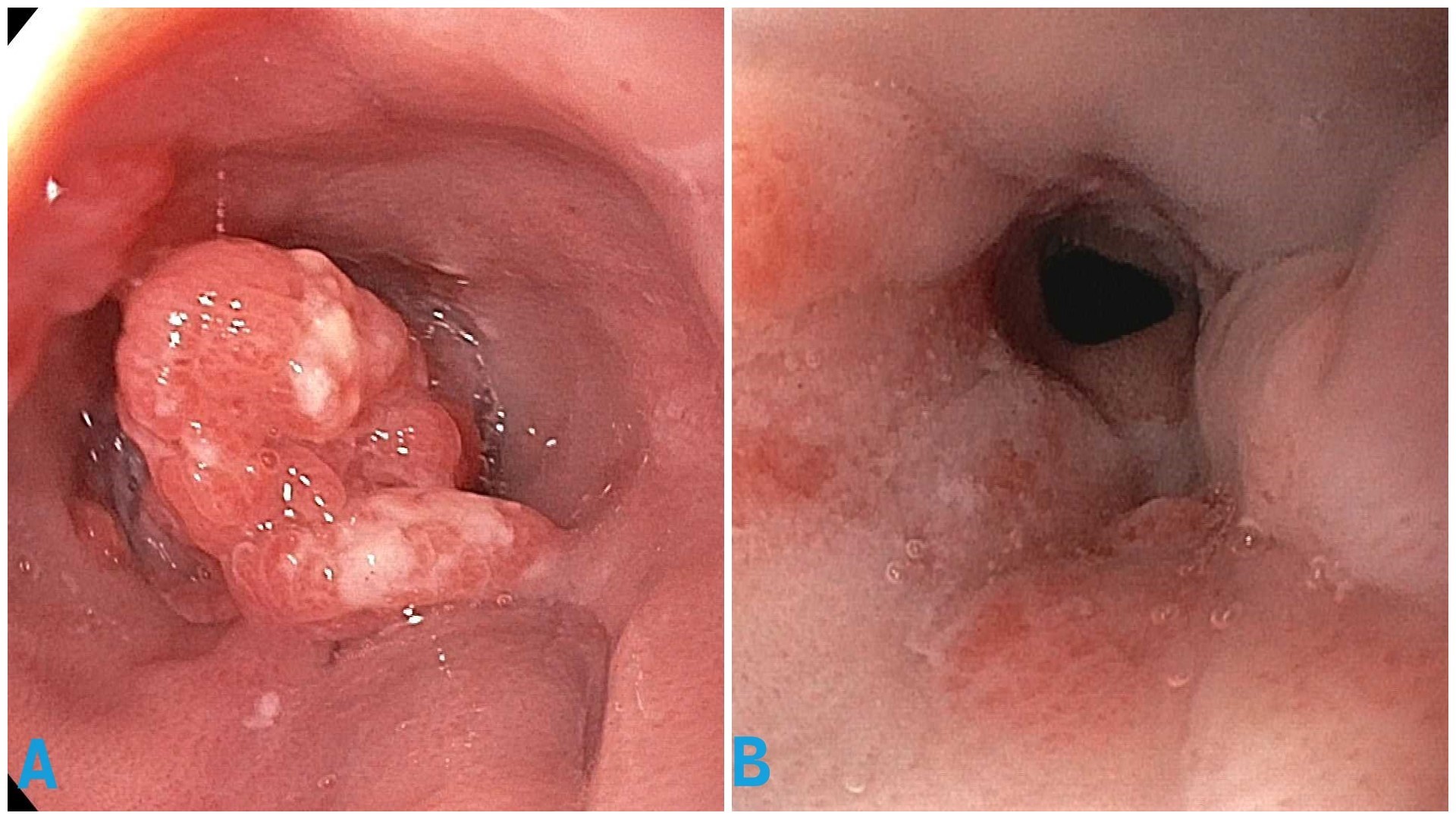Tuesday Poster Session
Category: Esophagus
P3981 - Esophageal Papilloma: An Unusual Presentation as a Large Obstructive Esophageal Mass
Tuesday, October 29, 2024
10:30 AM - 4:00 PM ET
Location: Exhibit Hall E

Has Audio

Haider Ghazanfar, MD
BronxCare Health System
Bronx, NY
Presenting Author(s)
Haider Ghazanfar, MD, Priscilla Lajara Hallal, MD, Anil Dev, MD, Harish Patel, MD
BronxCare Health System, Bronx, NY
Introduction: Comprehensive evaluation of dysphagia to solid foods frequently identifies an esophageal mass. Malignancy represents the primary concern in the management of patients with such masses Endoscopic biopsy have a valuable diagnostic yield for malignancy , yet with negative biopsy persistent warrants re-evaluation to exclude cancer. The benign esophageal lesion contributes only 2% of all esophageal masses. We present a rare case of esophageal papilloma presenting as a large sizeable esophageal mass.
Case Description/Methods: Our patient is a 65 year old female with co-morbid conditions includes Human Immunodeficiency Virus infection (HIV) evaluated for the progressive dysphagia to solid food for a duration of 1 to 2 years. Patient reported that she has to chase the solid bolus with water to prevent the food impaction. Physical exam was unrevealing for oral candidiasis or neck and supra-clavicular lymph nodes. Her esophagogastroduodenoscopy (EGD) revealed a medium size fungating mass in lower esophagus at 35 centimeters from incisors. The pathology of the mass revealed superficial fragment of the atypical papillary proliferation with no atypical cells. The endoscopic ultrasound (Endoscopic Ultrasound) revealed a primary submucosal mass (layer 3) with no abnormality of mediastinal lymph nodes. Repeat biopsy did not reveal any alternate diagnosis. Esophageal lesion was excised with cold snare assisted endoscopic mucosal resection (EMR) with application of argon plasma coagulation (APC) to be base of esophageal lesion. Histopathological examination revealed fragments of the squamous papilloma with no dysplasia. The patient reported symptom improvement following EMR. She declined the HPV vaccine. A follow-up EGD three months post-EMR showed no residual growth.
Discussion: Malignancy represents the predominant cause of esophageal masses, whereas benign lesions of the esophagus are rare. Esophageal papilloma seldom manifest as large esophageal mass and can mimic malignancy. Endoscopic mucosal resection (EMR) and thermal therapy are effective treatments for esophageal papilloma can alleviate symptoms, additionally HPV vaccination is recommended.

Disclosures:
Haider Ghazanfar, MD, Priscilla Lajara Hallal, MD, Anil Dev, MD, Harish Patel, MD. P3981 - Esophageal Papilloma: An Unusual Presentation as a Large Obstructive Esophageal Mass, ACG 2024 Annual Scientific Meeting Abstracts. Philadelphia, PA: American College of Gastroenterology.
BronxCare Health System, Bronx, NY
Introduction: Comprehensive evaluation of dysphagia to solid foods frequently identifies an esophageal mass. Malignancy represents the primary concern in the management of patients with such masses Endoscopic biopsy have a valuable diagnostic yield for malignancy , yet with negative biopsy persistent warrants re-evaluation to exclude cancer. The benign esophageal lesion contributes only 2% of all esophageal masses. We present a rare case of esophageal papilloma presenting as a large sizeable esophageal mass.
Case Description/Methods: Our patient is a 65 year old female with co-morbid conditions includes Human Immunodeficiency Virus infection (HIV) evaluated for the progressive dysphagia to solid food for a duration of 1 to 2 years. Patient reported that she has to chase the solid bolus with water to prevent the food impaction. Physical exam was unrevealing for oral candidiasis or neck and supra-clavicular lymph nodes. Her esophagogastroduodenoscopy (EGD) revealed a medium size fungating mass in lower esophagus at 35 centimeters from incisors. The pathology of the mass revealed superficial fragment of the atypical papillary proliferation with no atypical cells. The endoscopic ultrasound (Endoscopic Ultrasound) revealed a primary submucosal mass (layer 3) with no abnormality of mediastinal lymph nodes. Repeat biopsy did not reveal any alternate diagnosis. Esophageal lesion was excised with cold snare assisted endoscopic mucosal resection (EMR) with application of argon plasma coagulation (APC) to be base of esophageal lesion. Histopathological examination revealed fragments of the squamous papilloma with no dysplasia. The patient reported symptom improvement following EMR. She declined the HPV vaccine. A follow-up EGD three months post-EMR showed no residual growth.
Discussion: Malignancy represents the predominant cause of esophageal masses, whereas benign lesions of the esophagus are rare. Esophageal papilloma seldom manifest as large esophageal mass and can mimic malignancy. Endoscopic mucosal resection (EMR) and thermal therapy are effective treatments for esophageal papilloma can alleviate symptoms, additionally HPV vaccination is recommended.

Figure: A: Esophagogastroduodenoscopy (EGD) showing Fungating Mass in the Lower Esophagus
B: Follow up EGD after the Endoscopic Mucosal Resection
B: Follow up EGD after the Endoscopic Mucosal Resection
Disclosures:
Haider Ghazanfar indicated no relevant financial relationships.
Priscilla Lajara Hallal indicated no relevant financial relationships.
Anil Dev indicated no relevant financial relationships.
Harish Patel indicated no relevant financial relationships.
Haider Ghazanfar, MD, Priscilla Lajara Hallal, MD, Anil Dev, MD, Harish Patel, MD. P3981 - Esophageal Papilloma: An Unusual Presentation as a Large Obstructive Esophageal Mass, ACG 2024 Annual Scientific Meeting Abstracts. Philadelphia, PA: American College of Gastroenterology.
